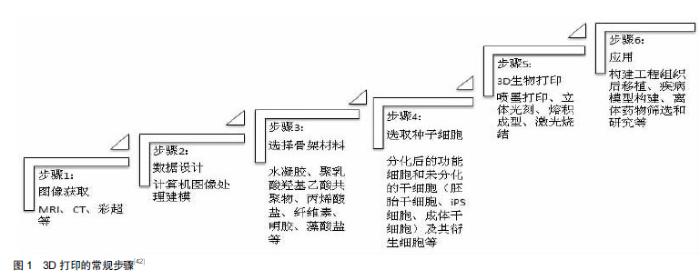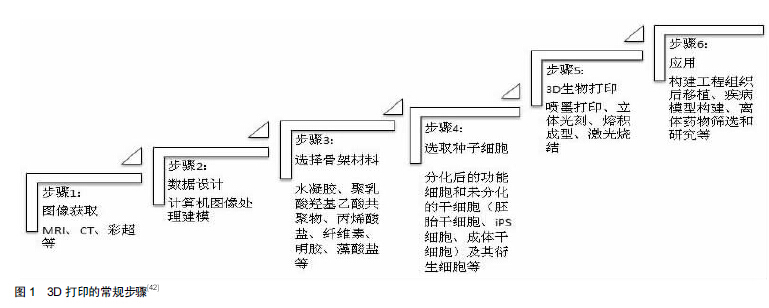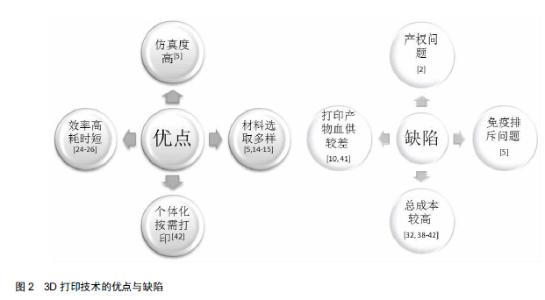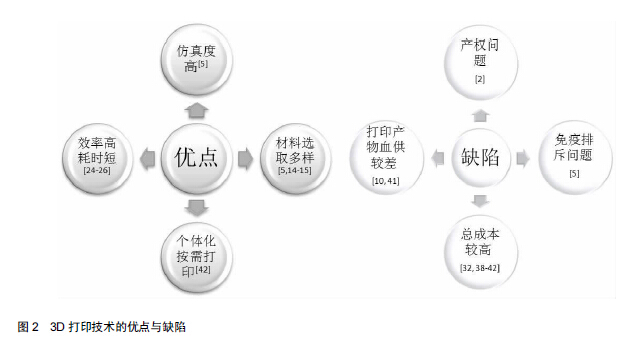Chinese Journal of Tissue Engineering Research ›› 2015, Vol. 19 ›› Issue (43): 7029-7034.doi: 10.3969/j.issn.2095-4344.2015.43.026
Previous Articles Next Articles
3D printing technology in the construction of tissue-engineered myocardium, heart valve, great vessels and vascular net
Wang Lu, Hu Wei-jie, Nie Hao, Sun Xiao-xi, Hong Xian, Xi Jiao-ya
- Department of Physiology and Chinese-German Stem Cell Center, Tongji Medical College, Huazhong University of Science and Technology, Brain Research Institute, the Key Laboratory for Drug Target Researches and Pharmacodynamic Evaluation of Hubei Province, Wuhan 430030, Hubei Province, China
-
Received:2015-07-22Online:2015-10-15Published:2015-10-15 -
Contact:Xi Jiao-ya, Associate professor, Department of Physiology and Chinese-German Stem Cell Center, Tongji Medical College, Huazhong University of Science and Technology, Brain Research Institute, the Key Laboratory for Drug Target Researches and Pharmacodynamic Evaluation of Hubei Province, Wuhan 430030, Hubei Province, China -
About author:Wang Lu, Studying for doctorate, Department of Physiology and Chinese-German Stem Cell Center, Tongji Medical College, Huazhong University of Science and Technology, Brain Research Institute, the Key Laboratory for Drug Target Researches and Pharmacodynamic Evaluation of Hubei Province, Wuhan 430030, Hubei Province, China -
Supported by:the National Nature Science Foundation of China, No. 31100828; the Fundamental Research Funds for the Independent Innovation in Huangzhong University of Science and Technology, No. 2013TS145; the National Undergraduate Training Programs for Innovation and Entrepreneurship, HUST, No. 20150487075 and 20150487077
Cite this article
Wang Lu, Hu Wei-jie, Nie Hao, Sun Xiao-xi, Hong Xian, Xi Jiao-ya. 3D printing technology in the construction of tissue-engineered myocardium, heart valve, great vessels and vascular net[J]. Chinese Journal of Tissue Engineering Research, 2015, 19(43): 7029-7034.
share this article
|
[1] 邢远翔.3D打印颠覆医学传统理念[J].中国医院院长,2014, 10(19): 36.
[2] Ventola CL.Medical Applications for 3D Printing: Current and Projected Uses.P T.2014;39(10):704-711.
[3] Mahmood F,Owais K,Montealegre Gallegos M,et al. Echocardiography derived three-dimensional printing of normal and abnormal mitral annuli. Ann Card Anaesth. 2014; 17(4):279-283.
[4] Witschey WR,Pouch AM,McGarvey JR,et al. Three-dimensional ultrasound-derived physical mitral valve modeling.Ann Thorac Surg.2014;98(2):691-694.
[5] Lueders C,Jastram B,Hetzer R,et al.Rapid manufacturing techniques for the tissue engineering of human heart valves.Eur J Cardiothorac Surg.2014;46(4):593-601.
[6] Costello JP,Olivieri LJ,Krieger A,et al.Utilizing three-dimensional printing technology to assess the feasibility of high-fidelity synthetic ventricular septal defect models for simulation in medical education.World J Pediatr Congenit Heart Surg. 2014;5(3):421-426.
[7] O’Neill B,Wang DD,Pantelic M,et al.Transcatheter caval valve implantation using multimodality imaging: roles of TEE, CT, and 3D printing.JACC Cardiovasc Imaging. 2015;8(2): 221-225.
[8] Olivieri LJ,Krieger A,Loke YH,et al.Three-dimensional printing of intracardiac defects from three-dimensional echocardiographic images: feasibility and relative accuracy.J Am Soc Echocardiogr.2015;28(4):392-397.
[9] Koroleva A,Gittard S,Schlie S,et al.Fabrication of fibrin scaffolds with controlled microscale architecture by a two-photon polymerization–micromolding technique. Biofabrication.2012;4(1):015001.
[10] Lee VK,Kim DY,Ngo H,et al.Creating perfused functional vascular channels using 3D bio-printing technology. Biomaterials. 2014;35(28):8092-8102.
[11] Christensen K,Xu C,Chai W,et al.Freeform Inkjet Printing of Cellular Structures with Bifurcations.Biotechnol Bioeng.2014; 112(5):1047-1055.
[12] Poldervaart MT,Gremmels H,van Deventer K,et al.Prolonged presence of VEGF promotes vascularization in 3D bioprinted scaffolds with defined architecture. J Control Release. 2014; 28(184):58-66.
[13] Zhao X,Liu L,Wang J,et al.In vitro vascularization of a combined system based on a 3D printing technique.J Tissue Eng Regen Med.2014. doi: 10.1002/term.1863.[Epub ahead of print]
[14] Pati F,Jang J,Ha DH,et al.Printing three-dimensional tissue analogues with decellularized extracellular matrix bioink.Nat Commun.2014;5:3935.
[15] Petrochenko PE,Torgersen J,Gruber P,et al.Laser 3D Printing with sub-microscale resolution of porous elastomeric scaffolds for supporting human bone stem cells.Adv Healthc Mater.2015,4(5):739-747.
[16] Park CJ,Kim HW,Jeong S,et al.Anti-reflux ureteral stent with polymeric flap valve using three-dimensional printing: An in vitro study.J Endourol.2015.[Epub ahead of print]
[17] Mahmood F,Owais K,Taylor C,et al.Three-Dimensional Printing of Mitral Valve Using Echocardiographic Data.JACC Cardiovasc Imaging.2015;8(2):227-229.
[18] Namba K,Higaki A,Kaneko N,et al.Microcatheter shaping for intracranial aneurysm coiling using the 3-dimensional printing rapid prototyping technology: preliminary result in the first 10 consecutive cases.World Neurosurg.2015;84(1):178-186.
[19] Ozbolat IT,Yu Y. Bioprinting toward organ fabrication: challenges and future trends.IEEE Trans Biomed Eng. 2013; 3(60):691-699.
[20] Biglino G,Verschueren P,Zegels R,et al.Rapid prototyping compliant arterial phantoms for in-vitro studies and device testing.J Cardiovasc Magn Reson. 2013;15(2):1532.
[21] Gillis JA,Morris SF.Three-dimensional printing of perforator vascular anatomy. Plast Reconstr Surg.2014;133(1):80-82.
[22] Xu L,Gutbrod SR,Bonifas AP,et al.3D multifunctional integumentary membranes for spatiotemporal cardiac measurements and stimulation across the entire epicardium. Nat Commun.2014;5:3329.
[23] Sulkin MS,Widder E,Shao C,et al.Three-dimensional printing physiology laboratory technology.Am J Physiol Heart Circ Physiol.2013;305(11): H1569-1573.
[24] Dankowski R,Baszko A,Sutherland M,et al.3D heart model printing for preparation of percutaneous structural interventions. Kardiol Pol.2014;72(6):546-551.
[25] Schmauss D,Gerber N,Sodian R.Three-dimensional printing of models for surgical planning in patients with primary cardiac tumors.J Thorac Cardiovasc Surg.2013; 32(8): 773-785.
[26] Samuel BP,Pinto C,Pietila T,et al.Ultrasound-Derived Three Dimensional Printing in Congenital Heart Disease.J Digit Imaging.2015;28(4):459-461.
[27] Murphy SV,Atala A.3D bioprinting of tissues and organs. Nat Biotechnol.2014;32(8): 773-785.
[28] 杨帆,杨延坤,郑宏.3D 打印技术在先天性心脏病诊疗中的应用[J].中国介入影像与治疗学,2014,11(9):629-631.
[29] Olivieri L,Krieger A,Chen MY,et al.3D heart model guides complex stent angioplasty of pulmonary venous baffle obstruction in a Mustard repair of D-TGA.Int J Cardiol.2014; 172(2):297-298.
[30] 王安琪,冯晓明,杨昭鹏,等. 3D 打印在医疗器械领域的应用现状及展望[J].中国医疗器械信息,2014,20(8):1-7.
[31] Dankowski R,Baszko A,Sutherland M,et al. 3D heart model printing for preparation of percutaneous structural interventions: description of the technology and case report. Kardiol Pol.2014;72(6):546-551.
[32] Erkal JL,Selimovic A,Gross BC,et al.3D printed microfluidic devices with integrated versatile and reusable electrodes.Lab Chip.2014;14(12):2023-2032.
[33] Noecker AM,Chen JF,Zhou Q,et al.Development of patient-specific three-dimensional pediatric cardiac models. ASAIO J.2006;52(3):349-353.
[34] Costello JP,Olivieri LJ,Su L,et al.Incorporating three-dimensional printing into a simulation-based congenital heart disease and critical care training curriculum for resident physicians..Congenit Heart Dis.2015;10(2):185-190.
[35] Poterucha JT,Foley TA,Taggart NW.Percutaneous pulmonary valve implantation in a native outflow tract: 3-dimensional DynaCT rotational angiographic reconstruction and 3-dimensional printed model.JACC Cardiovasc Interv.2014; 7(10):151-152.
[36] Valverde I,Gomez G,Coserria JF,et al.3D printed models for planning endovascular stenting in transverse aortic arch hypoplasia.Catheter Cardiovasc Interv. 2015;85(6): 1006-1012.
[37] Lee SJ,Heo DN,Park JS,et al.Characterization and preparation of bio-tubular scaffolds for fabricating artificial vascular grafts by combining electrospinning and a 3D printing system.Phys Chem Chem Phys.2015;17(5): 2996-2999.
[38] 杨延坤,郑宏,徐争鸣,等.3D 打印技术辅助下经导管封堵主动脉窦瘤破裂一例[J].中国介入心脏病学杂志,2014,22(2):26.
[39] 刘凯,张学燕.3D打印机与CT 三维重建的结合应用[J].实用医技杂志,2013,20(6):666.
[40] Hoch E,Tovar GEM,Borchers K.Bioprinting of artificial blood vessels: current approaches towards a demanding goal.Eur J Cardiothorac Surg.2014;46(5):767-778.
[41] Lee VK,Kim DY,Ngo H,et al.Creating perfused functional vascular channels using 3D bio-printing technology. Biomaterials. 2014;35(28):8092-8102.
[42] Murphy SV,Atala A.3D bioprinting of tissues and organs.Nat Biotechnol.2014; 32(8):773-785.
|
| [1] | Zhang Tongtong, Wang Zhonghua, Wen Jie, Song Yuxin, Liu Lin. Application of three-dimensional printing model in surgical resection and reconstruction of cervical tumor [J]. Chinese Journal of Tissue Engineering Research, 2021, 25(9): 1335-1339. |
| [2] | Zeng Yanhua, Hao Yanlei. In vitro culture and purification of Schwann cells: a systematic review [J]. Chinese Journal of Tissue Engineering Research, 2021, 25(7): 1135-1141. |
| [3] | Xu Dongzi, Zhang Ting, Ouyang Zhaolian. The global competitive situation of cardiac tissue engineering based on patent analysis [J]. Chinese Journal of Tissue Engineering Research, 2021, 25(5): 807-812. |
| [4] | Wu Zijian, Hu Zhaoduan, Xie Youqiong, Wang Feng, Li Jia, Li Bocun, Cai Guowei, Peng Rui. Three-dimensional printing technology and bone tissue engineering research: literature metrology and visual analysis of research hotspots [J]. Chinese Journal of Tissue Engineering Research, 2021, 25(4): 564-569. |
| [5] | Chang Wenliao, Zhao Jie, Sun Xiaoliang, Wang Kun, Wu Guofeng, Zhou Jian, Li Shuxiang, Sun Han. Material selection, theoretical design and biomimetic function of artificial periosteum [J]. Chinese Journal of Tissue Engineering Research, 2021, 25(4): 600-606. |
| [6] | Liu Fei, Cui Yutao, Liu He. Advantages and problems of local antibiotic delivery system in the treatment of osteomyelitis [J]. Chinese Journal of Tissue Engineering Research, 2021, 25(4): 614-620. |
| [7] | Li Xiaozhuang, Duan Hao, Wang Weizhou, Tang Zhihong, Wang Yanghao, He Fei. Application of bone tissue engineering materials in the treatment of bone defect diseases in vivo [J]. Chinese Journal of Tissue Engineering Research, 2021, 25(4): 626-631. |
| [8] | Zhang Zhenkun, Li Zhe, Li Ya, Wang Yingying, Wang Yaping, Zhou Xinkui, Ma Shanshan, Guan Fangxia. Application of alginate based hydrogels/dressings in wound healing: sustained, dynamic and sequential release [J]. Chinese Journal of Tissue Engineering Research, 2021, 25(4): 638-643. |
| [9] | Chen Jiana, Qiu Yanling, Nie Minhai, Liu Xuqian. Tissue engineering scaffolds in repairing oral and maxillofacial soft tissue defects [J]. Chinese Journal of Tissue Engineering Research, 2021, 25(4): 644-650. |
| [10] | Xing Hao, Zhang Yonghong, Wang Dong. Advantages and disadvantages of repairing large-segment bone defect [J]. Chinese Journal of Tissue Engineering Research, 2021, 25(3): 426-430. |
| [11] | Chen Siqi, Xian Debin, Xu Rongsheng, Qin Zhongjie, Zhang Lei, Xia Delin. Effects of bone marrow mesenchymal stem cells and human umbilical vein endothelial cells combined with hydroxyapatite-tricalcium phosphate scaffolds on early angiogenesis in skull defect repair in rats [J]. Chinese Journal of Tissue Engineering Research, 2021, 25(22): 3458-3465. |
| [12] | Wang Hao, Chen Mingxue, Li Junkang, Luo Xujiang, Peng Liqing, Li Huo, Huang Bo, Tian Guangzhao, Liu Shuyun, Sui Xiang, Huang Jingxiang, Guo Quanyi, Lu Xiaobo. Decellularized porcine skin matrix for tissue-engineered meniscus scaffold [J]. Chinese Journal of Tissue Engineering Research, 2021, 25(22): 3473-3478. |
| [13] | Mo Jianling, He Shaoru, Feng Bowen, Jian Minqiao, Zhang Xiaohui, Liu Caisheng, Liang Yijing, Liu Yumei, Chen Liang, Zhou Haiyu, Liu Yanhui. Forming prevascularized cell sheets and the expression of angiogenesis-related factors [J]. Chinese Journal of Tissue Engineering Research, 2021, 25(22): 3479-3486. |
| [14] | Liu Chang, Li Datong, Liu Yuan, Kong Lingbo, Guo Rui, Yang Lixue, Hao Dingjun, He Baorong. Poor efficacy after vertebral augmentation surgery of acute symptomatic thoracolumbar osteoporotic compression fracture: relationship with bone cement, bone mineral density, and adjacent fractures [J]. Chinese Journal of Tissue Engineering Research, 2021, 25(22): 3510-3516. |
| [15] | Liu Liyong, Zhou Lei. Research and development status and development trend of hydrogel in tissue engineering based on patent information [J]. Chinese Journal of Tissue Engineering Research, 2021, 25(22): 3527-3533. |
| Viewed | ||||||
|
Full text |
|
|||||
|
Abstract |
|
|||||



